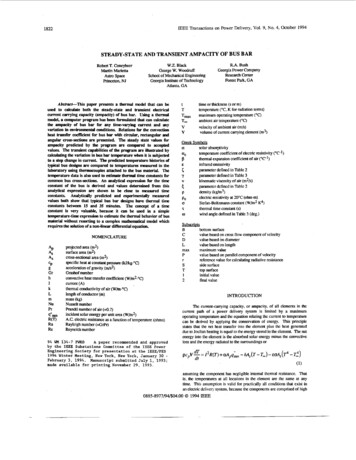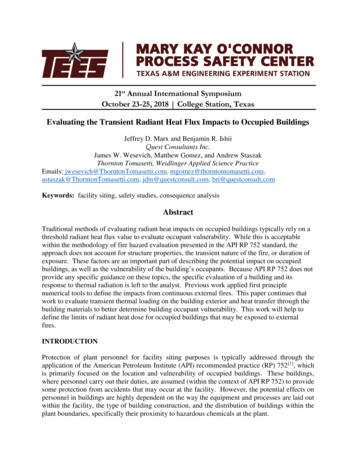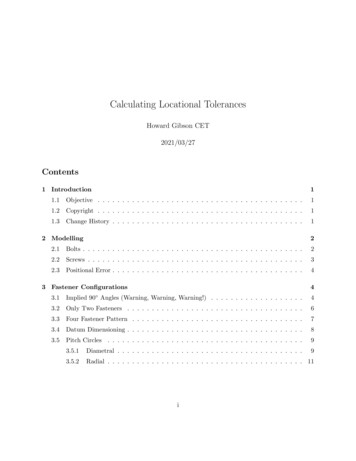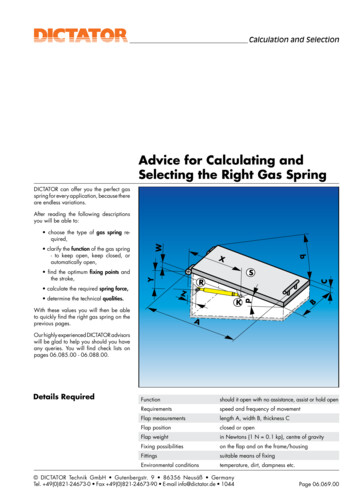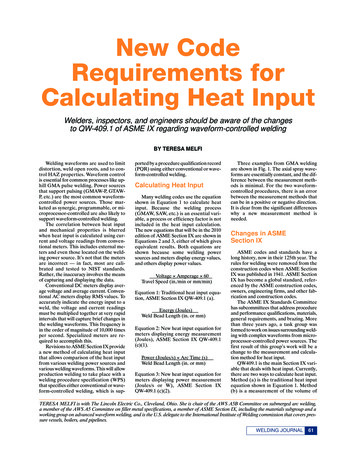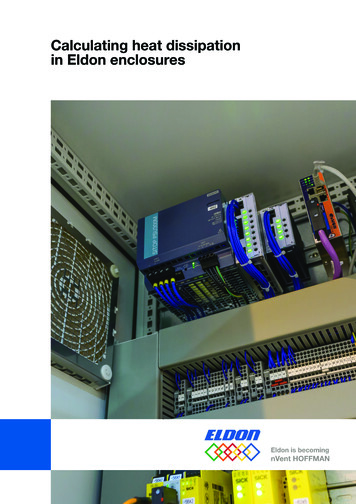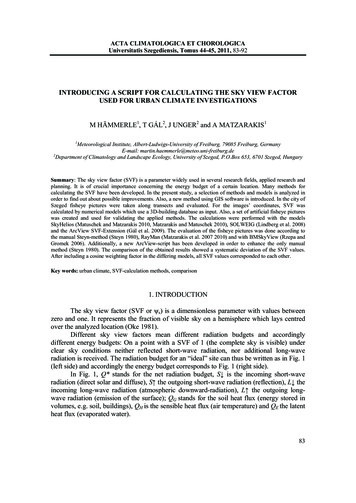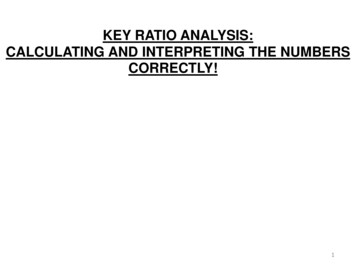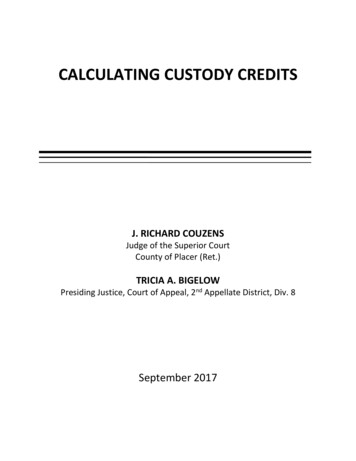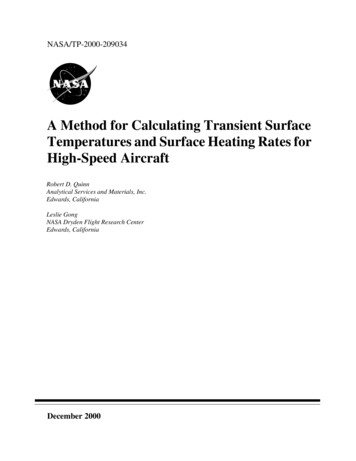
Transcription
NASA/TP-2000-209034A Method for Calculating Transient SurfaceTemperatures and Surface Heating Rates forHigh-Speed AircraftRobert D. QuinnAnalytical Services and Materials, Inc.Edwards, CaliforniaLeslie GongNASA Dryden Flight Research CenterEdwards, CaliforniaDecember 2000
The NASA STI Program Office in ProfileSince its founding, NASA has been dedicatedto the advancement of aeronautics and spacescience. The NASA Scientific and TechnicalInformation (STI) Program Office plays a keypart in helping NASA maintain thisimportant role.The NASA STI Program Office is operated byLangley Research Center, the lead center forNASA’s scientific and technical information.The NASA STI Program Office provides accessto the NASA STI Database, the largest collectionof aeronautical and space science STI in theworld. The Program Office is also NASA’sinstitutional mechanism for disseminating theresults of its research and development activities.These results are published by NASA in theNASA STI Report Series, which includes thefollowing report types: TECHNICAL PUBLICATION. Reports ofcompleted research or a major significantphase of research that present the results ofNASA programs and include extensive dataor theoretical analysis. Includes compilationsof significant scientific and technical dataand information deemed to be of continuingreference value. NASA’s counterpart ofpeer-reviewed formal professional papers buthas less stringent limitations on manuscriptlength and extent of graphic presentations.TECHNICAL MEMORANDUM. Scientificand technical findings that are preliminary orof specialized interest, e.g., quick releasereports, working papers, and bibliographiesthat contain minimal annotation. Does notcontain extensive analysis.CONTRACTOR REPORT. Scientific andtechnical findings by NASA-sponsoredcontractors and grantees. CONFERENCE PUBLICATION.Collected papers from scientific andtechnical conferences, symposia, seminars,or other meetings sponsored or cosponsoredby NASA. SPECIAL PUBLICATION. Scientific,technical, or historical information fromNASA programs, projects, and mission,often concerned with subjects havingsubstantial public interest. TECHNICAL TRANSLATION. Englishlanguage translations of foreign scientificand technical material pertinent toNASA’s mission.Specialized services that complement the STIProgram Office’s diverse offerings includecreating custom thesauri, building customizeddatabases, organizing and publishing researchresults even providing videos.For more information about the NASA STIProgram Office, see the following: Access the NASA STI Program Home Pageat http://www.sti.nasa.gov E-mail your question via the Internet tohelp@sti.nasa.gov Fax your question to the NASA Access HelpDesk at (301) 621-0134 Telephone the NASA Access Help Desk at(301) 621-0390 Write to:NASA Access Help DeskNASA Center for AeroSpace Information7121 Standard DriveHanover, MD 21076-1320
NASA/TP-2000-209034A Method for Calculating Transient SurfaceTemperatures and Surface Heating Rates forHigh-Speed AircraftRobert D. QuinnAnalytical Services and Materials, Inc.Edwards, CaliforniaLeslie GongNASA Dryden Flight Research CenterEdwards, CaliforniaNational Aeronautics andSpace AdministrationDryden Flight Research CenterEdwards, California 93523-0273December 2000
NOTICEUse of trade names or names of manufacturers in this document does not constitute an official endorsementof such products or manufacturers, either expressed or implied, by the National Aeronautics andSpace Administration.Available from the following:NASA Center for AeroSpace Information (CASI)7121 Standard DriveHanover, MD 21076-1320(301) 621-0390National Technical Information Service (NTIS)5285 Port Royal RoadSpringfield, VA 22161-2171(703) 487-4650
ABSTRACTThis report describes a method that can calculate transient aerodynamic heating and transient surfacetemperatures at supersonic and hypersonic speeds. This method can rapidly calculate temperature andheating rate time-histories for complete flight trajectories. Semi-empirical theories are used to calculatelaminar and turbulent heat transfer coefficients and a procedure for estimating boundary-layer transitionis included. Results from this method are compared with flight data from the X-15 research vehicle,YF-12 airplane, and the Space Shuttle Orbiter. These comparisons show that the calculated values are ingood agreement with the measured flight data.NOMENCLATUREaspeed of sound, ft/secBtuBritish thermal unitsc1, c2, c3, c4, c5defined by equations 38 through 42CFDcomputational fluid dynamicsCflocal skin friction coefficientCMtransition Mach number coefficientCp,wspecific heat of wall material, Btu/lbm RDFRCDryden Flight Research Center, Edwards, CaliforniaffunctionFempirical factor in transient heating and heat transfer coefficient equationsF.S.fuselage stationggravitational conversion factor, 32.17 lbm ft/lb sec2hheat transfer coefficient, lbm/ft2 secHenthalpy, Btu/lbmJmechanical equivalent of heat, 778 ft lb/BtuKradiation geometry factor 1.0mexponent in friction lawMMach numberNreciprocal exponent in velocity profile power lawPLstatic pressure at edge of boundary layer, lb/ft2Pststagnation pressure, lb/ft2P1static pressure in front of shock, lb/ft2PrPrandtl numberqheat flux, Btu/ft2 sec
q/q0ratio of circumferential heat flux on a sphere or cylinder to the stagnation pointheat fluxrradius of body of revolution, ftRradius of nose or leading edge, ftRgas constant for air, 53.3 ft lb/lbm RRASmodified Reynolds analogy factorρVxReynolds number, ----------µρVxtransition Reynolds number, ----------µρVθReynolds number based on momentum thickness, ----------µsolar and nocturnal radiation input, Btu/ft2 secSBspeed brakeSTStanton number, h/ρVttime, secTtemperatureTststagnation temperature, RTwT wwall or skin temperature, RVvelocity, ft/secW.S.wing stationxflow distance, ftβradiation factor, σεK, Btu/ft2 sec R4γratio of specific heatsδboundary-layer velocity thickness, ftεemissivityΖcompressibility factor in the thermal equation of state for airθboundary-layer momentum thickness, ftθscircumferential angle for a cylinder or sphere from stagnation line, degΛleading edge sweep angle, degµdynamic viscosity, lbm/ft secρdensity of air, lbm/ft3ρwdensity of wall material, lbm/ft3σStefan-Boltzman constant, 4.758 10–13 Btu/ft2 sec R4τwall or skin thickness, ftReRe, tRθ2rate of change of wall temperature, R/sec
φ du ------ dx x 0circumferential angle for a cone, zero on cone center line, degstagnation velocity gradient, 1/secSubscriptsLlocal flow conditions in the inviscid shear layer or at the edge of the boundary layerRboundary-layer recoveryststagnationwwall2conditions behind normal shockSuperscripts*evaluate at the reference enthalpyINTRODUCTIONThe Dryden Flight Research Center (DFRC) Edwards, California, conducts flight research on newand advanced high-speed aircraft. Dryden also conducts ground research on new and unique hotstructures concepts in the Flight Loads Research Laboratory. The ability to reliably calculate timehistories of transient aerodynamic heating rates and surface temperatures is essential to conduct thisresearch and to ensure flight safety.The best method for predicting aerodynamic heating is viscous computational fluid dynamics (CFD)solutions (refs. 1 and 2). This method provides a direct means of computing heat flux as well asinteractions between inviscid and viscous flow regions due to heat transfer and entropy-layer swallowing.However, these methods require large computer run times and storage, and each time the flightconditions change (e.g. the Mach number, altitude and angle of attack) a new computer run must bemade. Therefore, using CFD to calculate complete time histories of transient temperatures and heat fluxbecomes very expensive and time consuming. Further, for turbulent flow the accuracy of viscous CFDsolutions is suspect due to the required use of empirical turbulent models.Consequently, the use of viscous CFD solutions for calculating time histories of transient surfacetemperatures and aerodynamic heat flux is not feasible, and recourse to approximate aerodynamic heatingmethods is necessary. To meet these requirements for calculating transient surface temperatures and heatflux to conduct flight and laboratory research, an aerodynamic heating program called TPATH has beendeveloped. This program was originally developed to predict aerodynamic heating for flight safety andflight research on the X-15 research airplane. Subsequently, this program has been used to predicttransient surface temperatures and heating rates on all high speed flight vehicles flown at DFRC,including but not limited to the YF-12, SR-71, Space Shuttle, TU-144, Pegasus Hypersonic Experiment,and Hyper-X.3
This paper presents the heating methods used in this program and the methodology used to calculatetransient surface temperatures and surface heat flux for supersonic and hypersonic aircraft. The resultsare compared to flight data from the X-15 research airplane, the YF-12 airplane and the space shuttleorbiter.TRANSIENT AERODYNAMIC HEATINGAn aerodynamic heating program called TPATH has been developed at DFRC that is capable ofquickly and reliably calculating time histories of transient surface temperatures and surface heat flux atsupersonic and hypersonic speeds. This program uses approximate convective-heating methods to predicttransient surface temperature and heating rates for three-dimensional stagnation points, for twodimensional stagnation points with and without sweep, and for laminar and turbulent values withtransition for flat plates, wedges and cones. A detailed description of these methods together with themethodology used to apply these approximate methods to supersonic and/or hypersonic vehicles toobtain reliable results is described below.Stagnation PointThis section discusses transient heating equations and the heat transfer coefficient equations. Theseare the equations used to calculate stagnation point heating.Transient Heating EquationsThe equation used to calculate surface temperatures and heat flux for three-dimensional stagnationpoints and two-dimensional stagnation points without sweep is (ref. 3)*4q ( ρ w Cp, w τ )T w F ( h ) ( H st – H w ) – βT w S(1)and for two-dimensional stagnation points with sweep is4q ( ρ w Cp, w τ )T w F ( h ) ( H R – H w ) – βT w S(2)The S in equation 1 and 2 is for solar and nocturnal radiation input if required. This term is negligible4except for low-speed flow and is normally set equal to zero. The term βT w is the heat lost by radiationfrom the surface of the aircraft to the atmosphere.To obtain good surface temperatures and accurate heat flux, proper engineering judgment must beexercised in determining the heat capacity ( ρ w Cp, w τ ) for the surface. Since the values of the specificheat ( Cp, w ) and density ( ρ w ) are thermal properties of the material, the only way to significantly varythe heat capacity is to change the material thickness ( τ ) . For metallic leading edges with thickness up to*Thisequation is sometimes referred to as the thin-skin heat balance equation, and describes the heat balance where thesurface is represented by a single lump with a heat capacity of ( ρ w Cp, w τ ) .4
0.1 inches, equations 1 or 2 will produce satisfactory results. For material thickness greater than0.1 inches the following approximations should be used: equal to or less than 10 R/secFor surface temperature rise rates Twτ τ 0 0.5τ 1where τ0 0.1 inches, τ1 (τ – τ0), τ actual thickness and τ equivalent thickness.For surface temperature rise rates T w greater than 10 but less than 20 R/secτ τ 0 0.4τ 1For T w greater than 20 but less than 40 R/secτ τ 0 0.3τ 1and for T w greater than 40 R/secτ τ 0 0.2τ 1For metallic leading edges with thicknesses greater than 0.2 inches, it may be necessary to perform athermal analysis to verify the results.For surfaces that are insulated with low conductivity insulation (e.g. the space shuttle), a materialthickness should be used that will result in a heat capacity of approximately 0.1 Btu/ft2 R.Heat Transfer CoefficientsTo solve equations 1 and 2, the heat transfer coefficient (h) must be determined. In the TPATHprogram, the heat transfer coefficients are calculated by the method of Fay and Riddell (ref. 4) for threedimensional stagnation points. The method of Beckwith (ref. 5) is used for two-dimensional stagnationpoints with or without sweep. The equation given by Fay and Riddell for a Lewis number of 1.0 (nodissociation) and a Prandtl number of 0.71 may be written ash 0.94 ( ρ st µ st )0.4( ρw µw )0.1 du ------ dx (3)x 0and the equation given by Beckwith for a Lewis number of 1.0 and a Prandtl number of 0.71 may bewritten ash 0.704 ( ρ st µ st )0.44( ρw µw )0.06 du ------ dx (4)x 05
du ------ The velocity gradient dx is given byx 0 du ------ dx 1 2 ( P st – P 1 )g --- ------------------------------Rρ stx 0(5)and the stagnation enthalpy Hst for three-dimensional flow and two-dimensional flow with no sweep iscalculated by the following equation:2V2H st H 2 --------2gJ(6)where the subscript “2” denotes conditions calculated behind the normal shock. The wall enthalpy Hw isgiven by Hw ƒ(Tw, PL) and is determined from real gas tables obtained from ref. 6. For two-dimensionalflow with sweep, the recovery enthalpy is computed by the following equation:222V 1 sin ΛV2H R H 2 --------- 0.855 ---------------------2gJ2gJ(7)where the subscript “2” denotes conditions behind the swept normal shock, and 0.855 is the recoveryfactor as given in ref. 7. The velocity V2, enthalpy H2 and pressure P2 behind the normal shock arecomputed by the real gas solution of Moeckel (ref. 8). Using these normal shock values, the otherrequired flow conditions are calculated as follows: P 2γ 2 ------ ρ 2 (8)M2 V2 a2(9)P2ρ 2 -----------------Ζ 2 RT 2(10)a2 γ2 – 1 2P st P 2 1 --------------M 2 2γ2 – 1 2ρ st ρ 2 1 --------------M 2 26γ2-------------γ2 – 1(11)1-------------γ2 – 1(12)
γ2 – 1 2T st T 2 1 --------------M 2 2(13)P stρ w -------------------Ζ w RT w(14)The values for T2, γ2, ρ2, µw, µST and Ζ are determined from the real gas tables of ref. 6. It may benoted that the Ζ in equations 10 and 14 is the compressibility factor in the thermal equation of state forair.The application of the above method to calculate supersonic and hypersonic stagnation point andleading edge heating on flight vehicles is presented in Appendix A.Constant Entropy Solutions†The method used to calculate transient aerodynamic heating for constant entropy flow is discussed inthis section.Transient Heating EquationThe following equation is used to calculate transient surface temperatures and heat flux.4q ( ρ w Cp, w τ )T w ( h ) ( H R – H W ) – βT w S(15)Equation 15 is the same as equation 2 except that the empirical F factor in equation 2 is omitted. Aswas the case for stagnation point calculations, to obtain accurate surface temperatures and heat flux theproper value for the heat capacity (ρwCp,w τ) must be used. The only way to significantly vary the heatcapacity is to change the skin thickness (τ). For metallic surfaces the actual skin thickness gives goodresults for thickness up to 0.1 inches. For metallic thickness greater than 0.1 inches the value for τ givenin the previous section should be used, and for thicknesses greater than 0.2 inches, a thermal analysis maybe necessary. For surfaces that are insulated with low conductivity insulation (e.g. space shuttle), amaterial thickness should be used that results in a heat capacity of approximately 0.1 Btu/ft2 RLaminar Heat TransferTo solve equation 15 the heat transfer coefficients are calculated by the following relationship:– 0.60.332 ρ µ ( ρL VL )h ( F ) ---------------- ------------- ( Pr, w )ρµRe, L L L(16)which reduces to†Although constant entropy flow will only occur on a surface with a sharp leading edge or nose, many aircraft surfaces canbe approximated by shapes where constant entropy solutions can be used with good results.7
ρ µ V L– 0.6h ( F )0.332 -------------------- ( Pr, w )x(17)Equation 16 is based on the Blasius incompressible skin friction formula (ref. 10) and is related toheat transfer by a modified Reynolds analogy by the following formula:CfST RA ------2(18)where (Pr,w)-0.6 is the modified Reynolds analogy factor and the Stanton number “ST” is given by:hST ------ρV(19)Cf–1 2------- 0.332 ( Re, L )2(20)and the Blasius skin friction formula is:Compressibility effects are accounted for by Eckert’s reference enthalpy method (refs. 11 and 12),and the flow properties are evaluated at the reference enthalpy given by the following equation:H 0.5 ( H w H L ) 0.22 ( H R H L )(21)where2VLH R H L Pr, w --------2gJandH w f ( T w ,P L )H L f ( T L ,P L )T f ( H ,P L )µ f ( T ,P L )The values of Hw, HL, T* and µ* are obtained from real gas tables. (ref. 6).8(22)
The value for ρ* is calculated from the following equation:PLρ ------------------Ζ RT (23)where Ζ* f (T*,PL) and is obtained from ref.6.Turbulent Heat TransferThe turbulent heat transfer coefficient is obtained by solving for the turbulent skin friction coefficientand then relating the skin friction to heat transfer by a modified Reynolds analogy. Two methods areavailable in the TPATH to calculate turbulent heat transfer. The first is the skin friction theory ofvan Driest (ref. 13) given by the following equation:– 1 A – B 2A–10.242B 2A----------------------------- sin ------------------------------------ sin -----------------------------------22Hw( B 2A ) 1( B 2A ) 1A C f -------HL(24)Hw– 0.41 – log ( Re L C f ) 0.76 log -------- 0HLwhereA γ–1 2γ–1 2-----------M L1 -----------M L22-------------------- and B ------------------------------ – 1.0Hw HLHw HLThe heat transfer coefficient is then calculated by relating heat transfer to skin friction by equation 18and using the following modified Reynolds analogy factor:RA ( Pr, w )– 0.4(25)The heat transfer coefficient calculated by the van Driest method is then given by the followingequation:C f ρL VLh F -------------------------0.42 ( Pr, w )(26)The second method for calculating turbulent heat transfer in the TPATH program uses the followingincompressible skin friction equation:9
Cf0.185------- -----------------------------------2.5842( log Re, L )(27)This equation is transformed to the compressible plane by Eckert’s reference enthalpy method(ref. 11) resulting in the following equation for compressible skin friction:Cf ρ 0.185------- ---------------------------------- ------- 2.5842 ρ ( log Re )(28)where the density and viscosity in the Reynolds number are evaluated at the reference enthalpy (eq. 21),and the recovery enthalpy (HR) is computed from the following equation:H R H L ( Pr, w )1 3 2VL 2gJ(29)Equation 28 is then related to the heat transfer coefficient by a modified Reynolds analogy (eqs. 18,19 and 25) resulting in the following equation:– 0.40.185h F ---------------------------------- ( Pr, w )( ρ V L )2.584L ( log Re )(30)The enthalpy Hw and the Prandtl number Pr,w are functions of temperature and boundary-layer edgestatic pressure and are obtained from real gas tables. (ref. 6).The F factors in equation 17, 26, and 30 are usually used to correct two-dimensional heat transfercoefficient to conical flow values. The transformation factors are 1.73 and 1.15 for laminar and turbulentflow respectively. (ref. 11).The methods used to calculate the local flow values required to solve the above equations and theapplication of the above methods to calculated supersonic and hypersonic laminar and turbulent heattransfer on flight vehicles are discussed in Appendix B. It should be noted that real gas properties areused in all solutions. (ref. 6).Variable
NASA Access Help Desk NASA Center for AeroSpace Information 7121 Standard Drive Hanover, MD 21076-1320. NASA/TP-2000-209034 A Method for Calculating Transient Surface . heat and density are thermal prope
